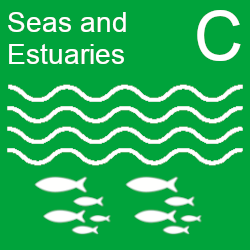Notice: From 01 December 2025, the Outcome Indicator Framework dashboard has been moved. Future updates to this publication are available on GOV.UK at: Environmental Indicator Framework.
Short Description
This indicator tracks changes in the distribution and intensity of potential physical disturbance caused by human activities on the seabed. The indicator combines data on the intensity and distribution of pressures from human activities with data on the distribution and sensitivity of seabed habitats. Data from vessel monitoring systems (VMS) showing fishing activity are linked to vessel logbook information and processed to create a layer showing abrasion pressure on the seabed. A second layer is produced by combining data on distribution of seabed habitats with information on resilience and resistance to evaluate their sensitivity to the pressure. The pressure and sensitivity layers are combined using a spatial method to create a single data layer showing the area of seabed subject to high disturbance from human activity. This indicator is linked to the ‘Extent of Physical Disturbance to Benthic Habitats’ indicator, developed for the Convention for the Protection of the Marine Environment of the North-East Atlantic (OSPAR) and used for the UK Marine Strategy (UKMS) Part One (2019) assessment of Good Environmental Status (GES).
Readiness and links to data
An interim indicator is presented here that shows the predicted area of seabed in the UK Continental Shelf exposed to disturbance from mobile bottom-contact fishing, by vessels over 12 metres long. The assessments on disturbance used for this interim indicator, including data and analytical methods, have been reported under the updated UKMS Part One (2019). Further development will result in some changes to the method to include additional activities and improve the habitat sensitivity assessment.
There has been an update relevant to the development of this indicator published via the OSPAR Quality Status Report (QSR) in 2023, including an updated indicator assessment of the extent of physical disturbance from fisheries with mobile bottom-contacting gears, and a new indicator assessment on the extent of physical disturbance by commercial aggregate extraction activities. However, further development is required to make the latest assessments UK-relevant only, which will be completed via the UKMS in 2025.
Notes on indicator
The degree of disturbance to a habitat is an index based on the predicted spatial and temporal overlap of its sensitivity and exposure to a specific pressure. Sensitivity is assessed using the distribution of habitats and information on species presence collected across the reporting cycle (2010 to 2015). The annual values of the distribution and intensity of pressure are aggregated to give a single value, representative of pressure intensity for a reporting cycle. Sensitivity and pressure are combined via a matrix, producing 10 categories of disturbance ranging from 0 (no disturbance) to 9 (greatest risk of disturbance).
A lack of data relating to the activities of smaller fishing vessels (less than 12m) exists as they were not equipped with a VMS recorder at the time of the assessment. Consequently, there is an underestimate of disturbance in inshore waters, where smaller vessels predominantly operate. Additionally, fishing pressure layers were created in a gridded format which aggregates all fishing activity within a cell. Consequently, within a grid cell the intensity of fishing pressure, and the risk of disturbance, are potentially over or underestimated (i.e. fishing activity is not equally distributed).
The data presented here is from an assessment which pre-dates the 25 Year Environment Plan. However, this assessment provides an initial baseline from which to measure progress towards the goals of the 25 Year Environment Plan when the indicator is next updated. As stated in the Readiness and links to data section, an updated assessment of physical disturbance to benthic (seafloor) habitats has been conducted through the OSPAR QSR 2023. Following further developments via the UKMS in 2025 to make the assessment UK-relevant, this indicator will be updated.
Indicator components
Figure C2i: Predicted area of seabed in the UK Continental Shelf exposed to disturbance from bottom contact fishing by vessels over 12m long and regional progress towards Good Environmental Status (GES) 2010 to 2015
Table C2i: Predicted area of seabed in the UK Continental Shelf exposed to disturbance from bottom contact fishing by vessels over 12m long and regional progress towards Good Environmental Status (GES) 2010 to 2015
| Area | High disturbance (categories 5 to 9) | Low disturbance (categories 0 to 4) |
|---|---|---|
| English Channel | 75 | 25 |
| Northern Celtic Seas | 31 | 69 |
| Northern North Sea | 50 | 50 |
| OSPAR Region I | 0 | 0 |
| OSPAR Region IV | 0 | 0 |
| OSPAR Region V | 12 | 88 |
| Southern Celtic Seas | 75 | 25 |
| Southern North Sea | 48 | 52 |
Trend description for C2i
The results from 2010 to 2015 show pressure and disturbance caused by fishing activities to be widespread, occurring to some degree in 57% of the cells within UK waters. The chart shows the aggregated values for seafloor disturbance from bottom-contact fishing for the period 2010 to 2015. The highest level of disturbance is found in the English Channel and Southern Celtic Seas with 75% of both these areas being subject to high disturbance (categories 5 to 9). The extent of disturbance in the Northern North Sea and Southern North Sea is lower, 50% and 48% respectively, but still considerably above the target figure for GES. Within each assessment area there are grid cells showing no disturbance or low disturbance (categories 0 to 4), such as some central areas of the Northern North Sea. The Wider Atlantic (OSPAR Region V) was the only region to achieve GES over the assessment period 2010 to 2015 with 12% of its area subjected to high disturbance from bottom contact fishing.
Assessment of change
There is currently no assessment of change due to constraints of current data availability. In future updates, changes over time might be identified by comparing results from multiple reporting cycle assessments, such as those produced by the UKMS every 6 years. Future assessments may enable any trends to be identified, for example the number of regions achieving GES or estimates of annual disturbance intensity and distribution changing over time.
Image C2ii: Predicted area of seabed in the UK Continental Shelf exposed to disturbance from bottom contact fishing vessels over 12m long, 2010 to 2015
Trend description for C2ii
The results from 2010 to 2015 show pressure and disturbance caused by fishing activities to be widespread, occurring to some degree in 57% of the cells within UK waters. The chart shows the aggregated values for seafloor disturbance from bottom fishing for the period 2010 to 2015. The highest level of disturbance is found in the English Channel and Southern Celtic Seas with 75% of both these areas being subject to high disturbance (categories 5 to 9). The extent of disturbance in the Northern North Sea and Southern North Sea is lower, 50% and 48% respectively, but still considerably above the target figure for GES. Within each assessment area there are grid cells showing no disturbance or low disturbance (categories 0 to 4), such as some central areas of the Northern North Sea. The Wider Atlantic (OSPAR Region V) was the only region to achieve GES over the assessment period 2010 to 2015 with 12% of its area subjected to high disturbance from bottom contact fishing.
Assessment of change
There is currently no assessment of change due to constraints of current data availability. In future updates, changes over time might be identified by comparing results from multiple reporting cycle assessments such those produced by the UKMS every 6 years. Future assessments may enable any trends to be identified, for example the number of regions achieving GES or estimates of annual disturbance intensity and distribution changing over time.

